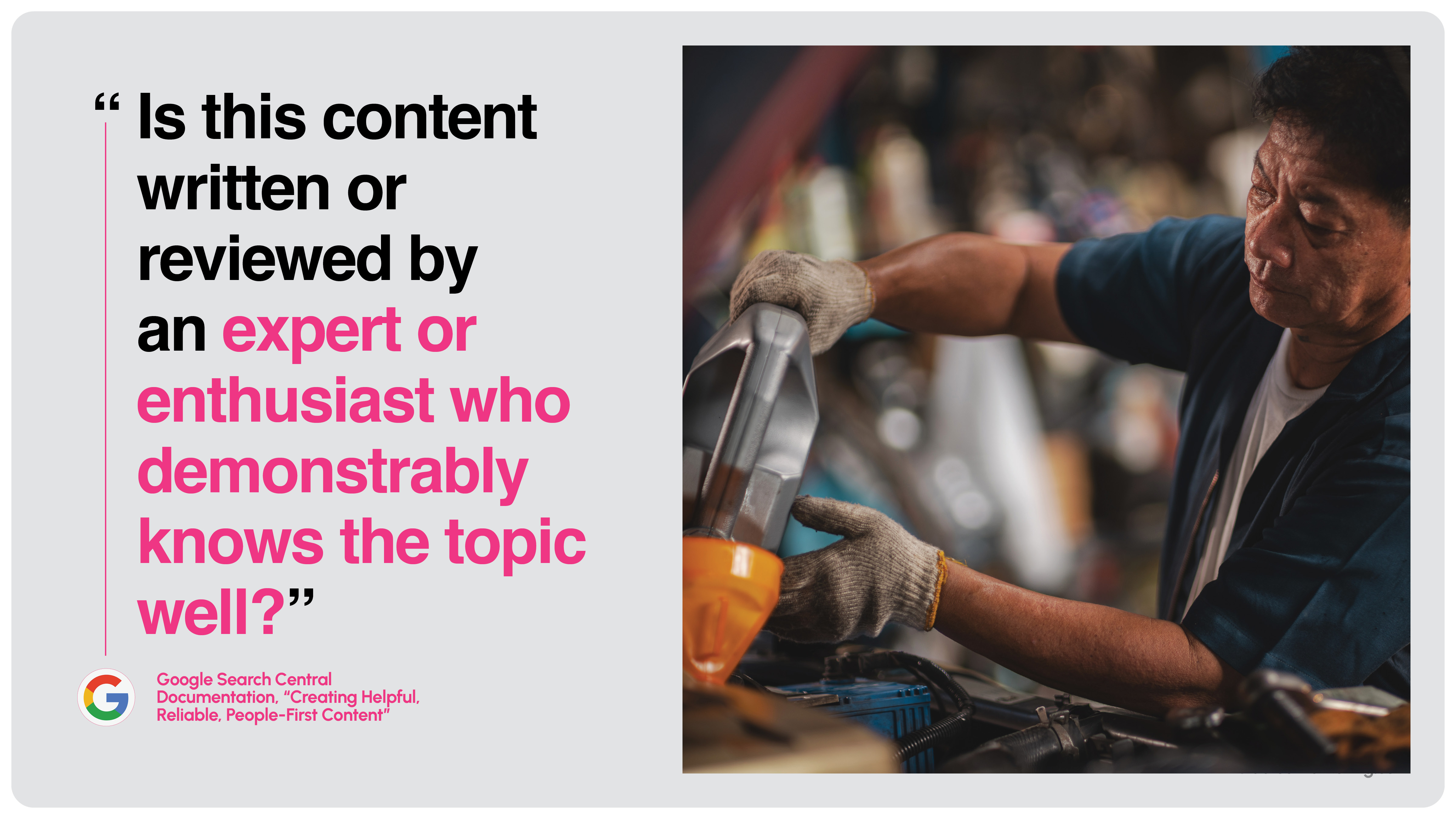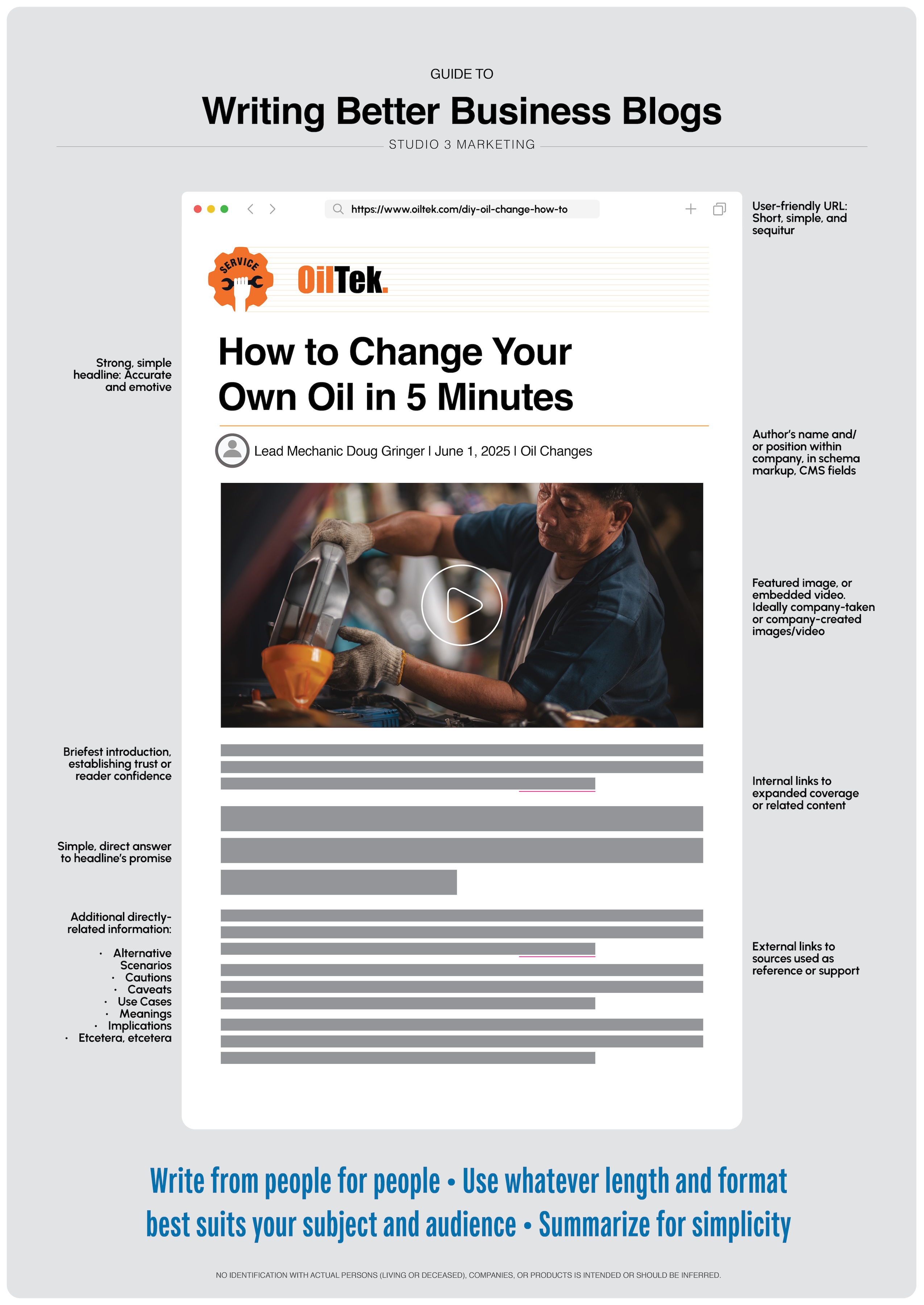
Anyone with a commercial presence on the internet has been told to “blog.”
Why? How? How often? For how long?
This article—and it is a blog—answers that for a brand or business.

These 15 tips will help you write blogs worth reading and worthy of ranking in search engines:
1. Ace the intro: Short and intriguing; establishing credentials or trust.
Get right into the meat of the matter. Skip or prune long, drawn-out introductions. Keep it brief and interesting. Its only purpose is to smoothly transition your reader right from the headline (your promise, or reason for writing), into what they need to know, and in a way that shows that your answer specifically is worth reading due to relevance, relatability, experience, or accuracy.
2. Start with the most significant stuff.
Start with the core takeaway, the reason you’re even writing at all, the most direct and immediately-applicable answer to your headline. If you promised to teach “How to Change Your Own Oil in 5 Minutes,” lay that out right now up front. Then cover whatever else your reader needs to know: caveats, cautions, or variables.
3. Waste no words. Write tightly…
Your blog shouldn’t be “as short as possible,” but it should be pretty tightly written. The easiest thing your reader can do is stop and click elsewhere. It’s the internet after all. It’s helpful to write tightly first, then come back for a review and rewrite of any part that’s overly wordy.
4. …but include as much directly relevant data as called for.
After laying out a short and accurate answer to your reader’s immediate question or concern, cover anything directly related that they also need to know. In our DIY oil change example, if the reader changes his own oil, how does he update CarFax so when he later goes to sell his car or file a warranty claim, his own oil changes will be on record? Include that, too.
Most of what people Google can be answered by “Yes,” “No,” or a bullet point list—hello Chat GPT and Bard—but your job is to help your reader understand the context of that single-sentence answer.
Answer what was asked, and then tell them something they didn’t even know they needed to know: Their next step, or the next problem they’re going to run into (and its solution or answer).

5. Write for your ideal reader, your future client.
Your ideal reader is a person who’s actually doing or considering the very thing you’re discussing.
Ergo, 1) A potential client or customer for your business, or 2) A person who has the specific question or interest that your headline addresses.
What do we know, or what can we confidently assume, about a person who Google’s “are bing ads worthwhile”?
- That they have a product or service they want to advertise.
- They know enough to know there’s more to search and paid ads than Google alone.
- They’re likely considering actually running Bing ads.
- They’re unsure if these ads would ever be profitable; if they should just stick to Google or Facebook ads instead.
So that’s the reader for whom we should write directly. And, we can steer him or her in the direction of our (your) services. Maybe it’s paid ad management, or inexpensive website traffic generation, or writing and designing more effective ads, or faster website hosting, or, or, or.
Will other people read our blogs? Sure. Does it matter? No. Happy to help. But write for the person who’s actually doing or considering the very thing you’re discussing.
6. Quote your own experts.
If you’re the expert, write away, and subtly show readers and search engines that you know what you’re talking about: “Having changed oil professionally for 16 years, I’d suggest you change your own if you have to, but that you also see a service station who can update your CarFax report at least every 7-10,000 miles.”
If you aren’t the expert, quote your own people who are, and refer to them by name and/or title: “Oil Tek’s Lead Mechanic Doug Gringer, says you can safely change your own oil if you can check all of these boxes,” leading into a bullet point list of criteria.
Asking company experts to chime in and attributing quotes and expertise to them boosts both search engine optimization (SEO) and generative engine optimization (GEO).

(Expert authors: Be sure that the CMS, or content management system, you are using actually shows your name and title in the “author” field. A very common mistake is that these fields are populated with “Andy” or “Jacob,” which detracts from the “SEO” opportunities, which we’ll cover next.)
- Do This: Articles wholly written by a company expert are best published in the name and/or title of your expert: “Lead Mechanic Doug Gringer, Oil Tek.”
- And This: Non-expert articles are typically best published in the name of the company: “Oil Tek.”
- But Never This: Don’t publish a blog for your company under “Doug,” alone. This is schema mark up and authorship notes in Wordpress.
- Why? Because SEO.
7. Be human. Write with spirit or personality.
Businesses are understandably concerned about professionalism and tone of voice, but more often than not, readers want a personality of some kind to show through. Even a professional one. They want to know they’re reading something another real human wrote. (In a small informal survey, 66% of people say they’d stop reading a piece of content if they knew it was AI-written.) Exceptions where personality should be invisible: Manuals, directions, news reports.
8. Sprinkle in the “SEO,” or search engine optimization.
Company and brand bloggers should cover their field of expertise, rather than writing on anything that might “get traffic or rank well.” But they should also apply basic search engine optimization (SEO) techniques to what they choose to write and how they publish it. Readers matter most, but it’s algorithms that determine whether readers will ever be served your articles in answer to their search queries.
In addition to other best-practices we cover here (points 1-15), minimalist SEO for a blog article consists of:
- Linking to other related content on your own website.
- Linking out to (ideally expert) sources where you pulled information from.
- Adding “alt tags” to images: Text that tells search engines what the images show.
In summary, don’t ignore traffic potential, but don’t go too far outside of your wheelhouse for traffic alone. You’ll end up off-brand and off-topic, reaching fewer visitors likely to need your core product or service. Lawyers should stick to legal topics, home service professionals to the home.
9. Summarize the significant; the core takeaways.
Summarize the most important steps, facts, or points of your article. People aren’t just busy, they’re also new and uncertain about your topic. Use the blog format you feel is best for your topic and reader, but summarize large batches of text with a few bullet points at the start or end of your blog.
10. Show us with visuals, graphics, or charts.
While every article you write and publish should include a “featured image,” don’t let a lack of graphics or charts hold you back from publishing quality content. You can get free featured images from Pexels.com and a number of other platforms. Use them with attribution and remember that the best images you can use in a blog are photos you’ve personally taken, or graphics you create yourself. Because SEO.
11. Rewrite your headline for power and punch.
Your headline will stand alone on search engine results pages (SERPs) where it fights alone against 10 others. It needs to be bold enough to win The Click. Without being “click bait.” Perhaps our title “How to Change Your Own Oil in 5 Minutes,” becomes instead, “Yes, Change Your Own Oil. Here’s How,” or “Yes, Change Your Own Oil. 7 steps, 5 Minutes, 2 Warnings.”
12. Press publish.
Blogs are best written outside of the CMS you’re using: Write in Google Docs, publish in Wordpress. In establishing your own system and workflow, you’ll likely find that GoogleDocs for instance has better formatting, editing, and reviewing features than Wordpress does.

13. Keep us up-to-date on changes.
Update old content when answers or information changes.
- New laws change old advice and answers.
- New products are better or different.
- New studies impact old recommendations.
14. Repost or repurpose your blogs on social platforms.
Now that you’ve published a great piece of content, repost or repurpose it elsewhere but in smart (non spammy) ways. Post links to it on Facebook, LinkedIn, and Twitter, but for TikTok, YouTube, and Instagram, create a video or stills version of it instead.
15. Keep at it. Write and publish, write and publish, write and publish.
The sheer volume of output on the web makes it unlikely that a single article will immediately impact your traffic or revenue—use paid ads for that—but, published over time, good blogs will establish you as a value-providing authority in your field, and will impact both traffic and revenue.
And that’s how you can write a company blog article that’s worth reading and ranking.
Intrigued but overwhelmed?
Studio 3 Marketing’s Content Marketing services can help you do this and more.
We work with national brands and thought leaders in numerous industries including legal, aesthetics, ecommerce, and multi-location franchises.
